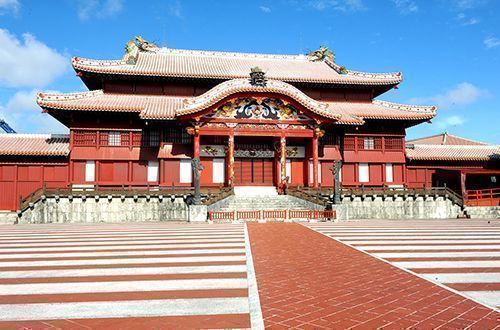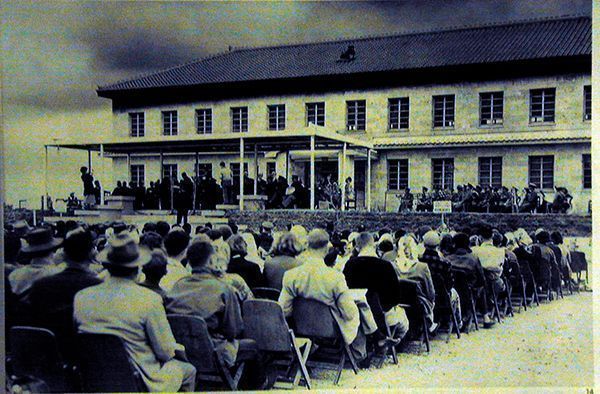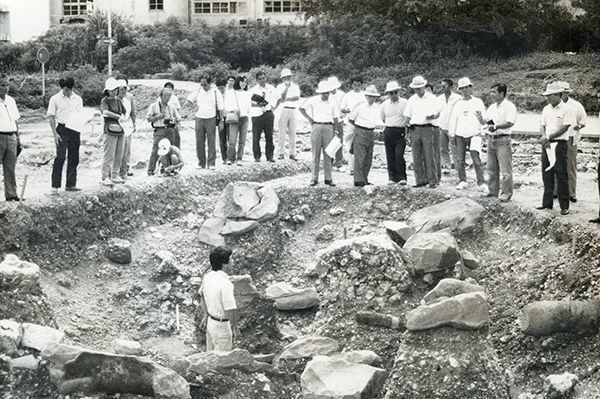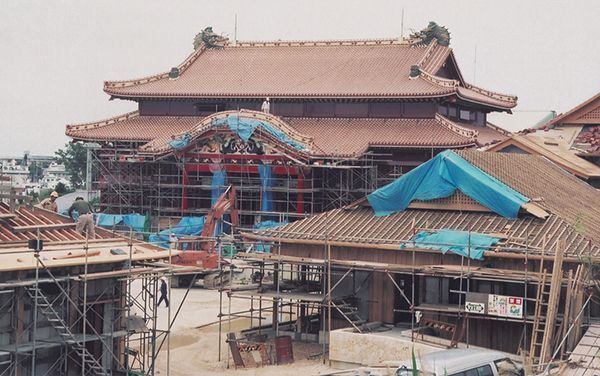A history lesson on the Shuri Castle reconstruction debate—Tokyo, or the prefecture?

Shuri Castle before the fire.
November 7, 2019 Ryukyu Shimpo
Mariko Nakamura
Nov. 7—It’s been one week since Shuri Castle’s seiden, or the main hall, was destroyed in a fire. A full investigation of the prefecture’s management will come, meanwhile, mapping out a path to reviving the castle is proving to be a challenge as well. Gov. Denny Tamaki visited Tokyo shortly after the fire and requested the Japanese government to rebuild the castle expeditiously. During the cabinet meeting on Nov. 6, Prime Minister Shinzo Abe indicated the government will assume charge of the reconstruction efforts including its funding. However, quite a significant number of Okinawans feel uneasy with a Japanese government-lead reconstruction of what is an “Okinawan symbol,” despite the Shuri Castle Park being a state-run park. Who should lead the project, the national government, or the prefecture? The public opinion in Okinawa is split. This article looks back on the history of Shuri Castle, before debates surrounding the project further intensifies.
Shuri Castle was built by Satto, the Chuzan King during the mid-14th century. The multi-storied castle was built in 1392, which is said to be the origins of the Shuri Castle’s main hall. In the following six centuries, the castle—the King’s home and workplace, burned down three times in succession wars. It was reconstructed each time.
In 1879, the Japanese government sent 600 Kumamoto-chindaihei (soldiers of ancient Japan) and policemen to Ryukyu; the men entered Shuri Castle and presented the Ryukyu king, Sho-Tai, with a letter instructing the King to abolish his rule and join Japan as a prefecture. Annexed by force (also known as the Ryukyu disposition,) Shuri Castle was surrendered to Japan and Okinawa Prefecture was established.

Meiji government soldiers pose for a photograph in front of the kankai-mon, the first main gate of the Shuri Castle. The soldiers, known as the Kumamoto-chindaihei, were deployed from Kumamoto Prefecture. (Courtesy of JCII Camera Museum)
In 1944, the Japanese 32nd Army set up its headquarters at Shuri Castle and dug a sizable underground network of tunnels beneath it, in preparation for the Battle of Okinawa. This made the castle a target for the U.S. military, and the castle was bombarded to ashes by naval gunfire.

A photo from Masahide Ota’s book, This was the Battle of Okinawa, shows Shuri Castle in ruins after the Battle of Okinawa.
Restoration and ownership of Shuri Castle
After World War II, the U.S. Military Government of the Ryukyu Islands controlled Okinawa, and made the decision to set up a university where the castle used to stand. Shuri Castle belonged to Shuri District prior to WWII, but the former City of Shuri took over after the war. According to an account given by Seimo Nakayama in the university’s 10th-anniversary magazine, Director Atsuo Yamashiro and Division Chief Dr. Arthur E. Mead of the Civil Information and Education Division of Ryukyu Military Government visited Shuri City Mayor Yuumei Kaneshima to discuss the using the Shuri Castle site as a university campus. The land-rights were turned over after the Shuri City Council passed a resolution.

The opening ceremony of the University of the Ryukyus, built where Shuri Castle used to be.
When Okinawa was returned to Japan in 1972, the University of the Ryukyus was entrusted to the national government, becoming a national university. The Act on Special Measures Incidental to the Reversion of Okinawa clearly dictates that the rights and obligations of the university will be set forth by the National School Special Account Act.
Shinichi Isa, former Ryukyu university staff and historian of modern Okinawan history, asserts that “The 1972 ‘transfer’ of land rights from the Ryukyu government to the Japanese government is the reason behind Okinawa’s increasing dependency on Tokyo.” Isa says there is no recorded testimony that shows Okinawan uncertainty over this “transfer” of rights, and theorizes that Okinawans may have been optimistic at the time.
Objections and concerns
The Ryukyu government put together a plan to restore war-damaged cultural assets and rebuild Shuri Castle, and requested the Japanese government to execute. Tokyo’s response was lukewarm, stating it would not build two national parks in the same prefecture.
Zenki Nakazato, former vice governor who served as section chief and director of tourism department of the prefectural government, urged the Japanese government to take action. He remembers that, “A state-run park would mean it’s state-owned, so Sadanori Yamanaka used to worry, ‘What would our people say? Will they object?’ I told him, it wouldn’t matter to Okinawans if the park was state-owned or prefecture-owned, [Shuri Castle] is an important inheritance for all Japanese citizens.” In 1986, The Cabinet decided the government will work on Shuri Castle as a state-run park. Nakazato said, “We have to credit Mr. Yamanaka.”

An on-site briefing of the excavation of Shuri Castle’s main hall, September 1986.
On the other hand, Okinawa had its own plans to construct a prefectural art college where the university campus used to be. However, Japan’s Ministry of Education held jurisdiction of the land, which complicated its acquisition. In the book Yomigaetta Shurijo (Literally: Shuri Castle revived,) Shigematsu Shiroma, minister of education at the time, said, “We really tried to acquire the site for free through amending the Law on Special Measures for the Promotion of Okinawa, as well as the Cabinet Order.”
Former director of Okinawa Development Agency, Mitsunori Ueki, was an LDP subcommittee chair at the time. He supported the negotiations and said, “Originally, the former City of Shuri gifted the Shuri Castle site to the University of the Ryukyus, which was then transferred to Japan upon Okinawa’s reversion. If you understand that history, you realize the prefecture need not pay for this acquisition.”

Shuri Castle under construction, March 1992.
After a push from both the public and private sectors, it was decided that the inner bailey of the Shuri Castle Park would be a state-run project, and the outer bailey would be a prefecture-run project.
But who will lead the reconstruction of the main hall lost in the fire? University of the Ryukyus Professor Emeritus Kurayoshi Takara, who previously worked on the restoration of the castle said, “We have experience with state-run projects to restore Shuri Castle. Can the prefecture rebuild the castle from scratch? We need to think about which government will be able to responsibly and expeditiously return the castle back to life.”
On the other hand, Isa points out that, “Given the long-talked-about issue of Okinawan independence, in the long-run it may be important for the prefecture to first take an independent approach, and assume the reins on a reconstruction plan.”
What roles should the prefecture and the national government play in this project? To arrive at an answer, a look at the site’s historical background and thoughtful discussions are imperative.
| Shuri Castle chronology | |
|---|---|
| Mid-14th century | Chuzan King, Satto, builds Shuri Castle |
| 1392 | The first main hall of Takayo Souri-den is constructed within the Shuri Castle grounds |
| 1879 | The Ryukyu Kingdom is annexed and dissolved. Shuri Castle is surrendered to the Japanese government |
| 1909 | Ownership of the castle is transferred to Shuri District. The district passes a resolution to demolish the site |
| 1925 | Shuri Castle’s main hall is designated a national treasure |
| 1928-1933 | Major repair of the main hall |
| 1944 | The Japanese Army sets up their headquarters at the castle, digs a tunnel network beneath it |
| 1945 | The castle is obliterated during the Battle of Okinawa |
| 1948 | Upon inspection, the decision to use the devastated site as the University of the Ryukyus campus is made by the U.S. Military Government of the Ryukyus |
| 1950 | The University of the Ryukyus opens its doors |
| 1970 | The Ryukyu government forms a restoration plan, puts it to the Japanese government |
| 1972 | Okinawa’s reversion to Japan |
| 1982 | Project proposal of “Shuri Castle Park” is worked into the second Okinawa development and promotion plan |
| 1984 | Mitsunori Ueki announces his shuri-suimui concept (National Shuri Castle Park concept). The prefecture creates a master plan based on Ueki’s ideas. Ryukyu University moves to Nishihara City |
| 1986 | Cabinet greenlights the project as the National Government Okinawa Commemorative Parks Shuri Castle Site. Okinawa prefectural decides the area surrounding the state-run park will be a prefecture-run park |
| 1989 | The inner bailey of Shuri Castle Park is transferred from the purview of the (former) Ministry of Education to the Okinawa General Bureau. Construction work of the main hall begins |
| 1992 | Partial opening of Shuri Castle Park |
| 2000 | The hokuden, or the north hall, serves as a venue to the G8 Summit banquet. The Shuri Castle ruins, Sonohyan-utaki and the Tamaudun masoleum are designated UNESCO World Heritage Sites |
(English translation by T&CT and Monica Shingaki)
Previous Article:Ryukyu red tile craftsmen appeal to prefectural government to preserve burned red tiles
Next Article:Fujian students perform Chinese fusion eisa on Kokusai Street
[Similar Articles]
- Looking back on Shuri Castle, world heritage site: 450 years of Okinawan politics and culture
- Shuri Castle’s main hall and north hall completely burned down with fire spreading to other buildings
- Six Dojos come together to perform Karate demonstration praying for the Shuri Castle reconstruction and to give courage to the region
- Basic Repairs on the Dragon Pillars which Remained Standing After the Fire at Shuri Castle
- Kumiodori celebrates 300 years, prayers for Shuri Castle
 Webcam(Kokusai Street)
Webcam(Kokusai Street)


